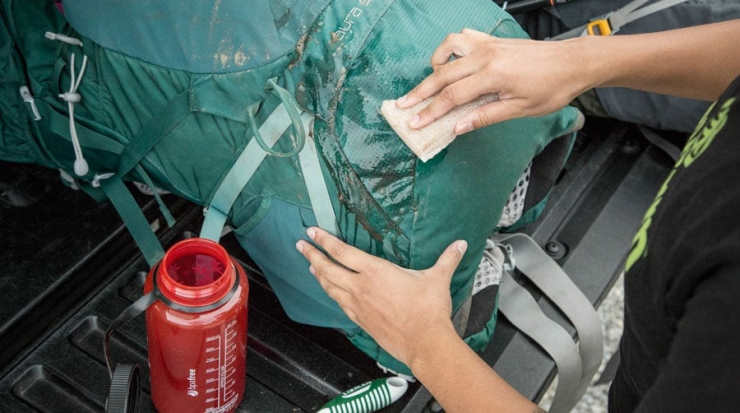Be it for school use or taking your laptop or other stuff to places, backpacks eventually get dirty. So, even though not as much as our clothes, backpacks need to be washed from time to time too. However, since these products can be made of different materials combined, there are things we need to be careful about to be able to use them for longer.
So, how to wash a backpack? Are they washing machine- and dryer-safe? In this article, you will get answers to these questions and learn some tips to make your backpack last longer. Of course, some backpacks might be made of leather or other materials that require a different kind of care, but we have taken all of these into consideration.

Can You Put a Backpack in the Washer?
The short answer is yes, most backpacks are washing machine safe. And what makes them washer safe is their material, which can be polyester, cotton, nylon, and canvas. However, if your backpack is made of suede, leather, or vinyl, washing them in the machine is not a good idea. And, of course, regardless of the material, you should always read the care label to see if hand washing is recommended.
Also, if your bad is waterproof or water repellent, avoid washing them in the washer. Because this may cause the waterproof coating to break down and leave you with a non-waterproof backpack. And if the manufacturer’s instruction says only dry clean, following that instruction should be your only way. With that being said, if your backpack is washer safe or you are just committed to using the washer, there are some steps you should follow.
How to Wash a Backpack in the Washer

Assuming that you have already read the care instructions label and confirmed that it is washer safe, look for instructions about the washer program and water warmth. If your backpack doesn’t have care instructions on it, you might try looking up the manufacturer’s site or test the fabric with just a little bit of detergent. Although, be careful to do the testing in a less obvious, hard-to-notice spot.
After completing this step, make sure that your backpack is completely empty. Not even a hanky should be left since it can crumble and ruin the insides of your backpack. After removing everything, leave the zippers open, turn your bag upside down and shake it to get rid of any dirt or crumbs. If you don’t have space to do this, you can also try gently vacuuming your bag.
Next, take off any hip belts, metal frames, and straps if possible. Then, search for obvious stains. If there are any big or small stains, get a damp sponge or a toothbrush to clean them gently. Now, your backpack is ready to go in the washing machine. Note that you should either turn the bag inside out or put it in a laundry sack before tossing it in the washer.
In my opinion, putting it inside a laundry bag is better than turning it inside out, besides, if you don’t have a laundry sack for bags, you can also use a pillowcase. Then, toss it in the washer and use a gentle detergent. Note that you should use only a small amount of detergent because excessive chemicals might harm the material. Also, the washer should be on a gentle cycle.
Still, if the bag bunches up during the spin cycle, you should stop the cycle and only go on after spreading it back out. This way, it can be washed thoroughly, and your machine stays protected from getting lopsided with a light load. After the cycle is finished, take the backpack out of the washer and the laundry sack and let it air dry. If at all possible, hang the bag upside-down, and before putting it away, make sure it is completely dry.
How to Wash a Backpack by Hand

The most secure way to clean a backpack is by hand washing. Certain bags, particularly those made for hiking, contain protective coatings that could degrade the washing machine. You should only wash your bag by hand if it is made of leather, has leather trim, or includes embellishments like iron-on patches or embroidery. So, what steps should you take when washing your backpack by hand?
Actually, the first steps are not much different, read the care instructions label, make sure your bag is completely empty, get rid of the dirt by shaking your bag or vacuuming it, take off the metal frames or belts and turn your bag inside out. Then, you can use a large basin, a bathtub, or a sink to wash your bag.
Start by filling whatever you choose to wash your bag with warm water and add only a spoonful of gentle detergent. Put the backpack right in the water if it can be soaked (see the care label). Then, scrub the backpack’s interior and outside with a sponge or washcloth. To get rid of any buildup, you can scrub the zippers with a sponge or an old toothbrush.
If the backpack has been soaked, drain the soapy water and refill the tub with clean, cool water to give it a good rinse. If you’ve merely used a sponge or cloth without soaking the bag, rinse the backpack with clean water after soaking the sponge to get rid of any detergent residue. Hang the bag up to dry naturally after carefully blotting away any extra moisture using an old cloth.
Can I Put a Backpack in the Dryer?
Okay, now that we know how to wash a backpack, what about drying it? Is it possible to toss a backpack in the dryer, or does heat harm the material? Even though it is much easier and more convenient just to put the bag in the dryer, you should never put a backpack in a dryer to prevent unwanted outcomes.
The material may become damaged, or the bag may shrink due to the machine’s heat. Besides, a lot of backpacks have plastic components that can melt in the dryer. In fact, you should even avoid letting your bag dry under the sun. Where you hang your bag to dry should be free from direct heat sources. So, make sure to hang it upside down to let every pocket dry completely.
How to Keep Your Backpack

Since washing and drying your backpack is a process that requires patience, time, and commitment, you might be wondering about ways of keeping it clean for a longer time. Well, with some small tips, not only can you prolong the time between cleanings, but it also can prolong your bag’s life. And for this, the most simple thing you can do is to get a waterproof backpack cover.
Also, any objects that could harm the bag, such as poles, tent pegs, or even sharp edges on boxes, should be packed so that it is unlikely that they would pierce the material. This can be accomplished by packing these items together so there is little room for movement or by placing them within softer items like garments.
Even if many backpacks are constructed of ripstop material and are therefore designed to be durable, you should still take care of your bag. Dragging a backpack over uneven terrain can degrade the material and develop holes. Try to hoist your backpack over your head when passing or walking through thorny or brambly areas to prevent them from tearing into your pack.
With that being said, eventually, typical wear and tear will have a negative impact on your backpack. While wiping them down frequently can help to prevent dirt from accumulating, you will need to wash your backpack thoroughly if it’s particularly dirty or has begun to smell. Though, this is something to be proud of since it means you have been to places!
Conclusion
So, to sum up, a backpack requires maintenance and can be a significant expenditure. Salts from your sweat and oil from your skin will probably leak into the shoulder straps and hip belts, whether you’re wearing a daypack or a huge backpack. Cooking splatters may result in grease stains. All of these can weaken the cloth over time by luring dirt. Zippers can clog up and become challenging to use.
Food crumbs in the pockets could attract animals’ unwanted attention. And all of these are good reasons to keep your backpack clean. Although washing your backpack may be time-consuming, this is a must if you want it to be there for you for a longer period. Just remember to always look for the manufacturer’s care instructions, and don’t ever toss your backpack in the dryer; your backpack will be just fine.




